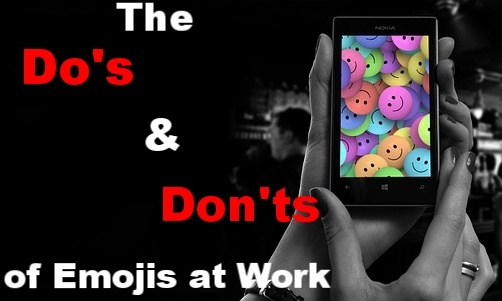World Emoji Day is marked by the iPhone calendar emoji as July 17. In 2015, people began celebrating the day by posting their favorite emojis to Twitter, Facebook, and other social media sites. Of course, anyone can have fun with emojis online, but what can employees do who are working all day? Is sending a celebration emoji in a workplace email appropriate, or should they maintain their place online and in text messaging?

Back in 1982, Scott Fahlman sent the first recorded smiley emoticon, “: – ),” in an email. He wanted the symbol to be used for jokes, but now the emoticons have evolved into a whole assortment of emotions. While Fahlman may not have been sending a professional email, many people wonder if communicating this way in the workplace is appropriate. There have been numerous inquiries about email etiquette throughout the years, especially within the past decade. Using too many exclamation points and adding text lingo such as “lol” or “omg” are both universally accepted as unprofessional. Many businesses prefer not to let their employees use them, but others have been more lenient if they are used in the right way. Emojis have been gaining traction over the past few years, so it’s time that we take a look at the do’s and don’ts of emoji usage in the workplace.
DO:
![]() Understand email etiquette – If you are ever unsure about whether to send an emoji email, then you should probably check with your coworkers to make sure it is okay to send. Check to see if your company has a style guide for how to send formal vs. informal emails.
Understand email etiquette – If you are ever unsure about whether to send an emoji email, then you should probably check with your coworkers to make sure it is okay to send. Check to see if your company has a style guide for how to send formal vs. informal emails.
Avoid ambiguity – Emojis can mean different things to different people. For example, what I think is an emoji for being upset, you may think is an emoji for being tired. If you do decide to use them, it’s probably best to stick to the simple happy and sad faces for less confusion.
Determine the right context – Should you be using laughing face emojis when discussing poor company performance? No. This example may be extreme, but examining the context of your email is important to avoid awkwardness or rudeness.
DON’T
Overuse – Just like using more than one exclamation mark is unadvisable, so is using more than one emoji. Adding too many of them to your emails may annoy others and cause confusion as to what you are trying to say.
Use to get a point across – What would you think if your boss sent you an email that said, “Bring those reports to my office tomorrow or you’re fired :)”? Your boss may be  using the smiley to get the point across that he is joking with you, but this type of message can be misinterpreted. Being outright and frank with coworkers is always the best option.
using the smiley to get the point across that he is joking with you, but this type of message can be misinterpreted. Being outright and frank with coworkers is always the best option.
Send to your boss – This may seem self-explanatory, but the majority of authority figures in your workplace want to be treated with respect. While you may think you are being friendly, your boss may think you are being unprofessional.
This outline of rules for emojis at work is not anything that should be set in stone. The guidelines for language and communication are changing every day. Five years ago, using emojis in professional emails was unheard of, but now 78% of Americans are using them at work, according to one survey. The truth is that communication evolves over time, and only you know best how to interact at your company. Some people may send an emoji email celebrating July 17, and others may not do anything at all. Whatever you do, we want to wish you a Happy World Emoji Day!
Do you use emojis for work purposes?

